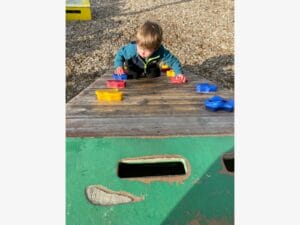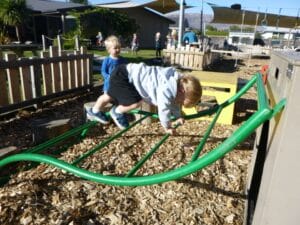
Resource—


Risky outdoor play has been a natural and important part of children’s lives for generations. However, changes in attitudes are having a negative impact on the opportunities for children to play freely outdoors. This aversion towards risky play is a bit of a modern-day dilemma as it has the potential to deny children opportunities to learn valuable lessons.
Teachers play a fundamental role in facilitating risky play for tamariki; however, sometimes there can be a struggle when balancing the health and safety of children in their care with providing these opportunities. Risk taking is something to be appreciated and we should try to actively reflect on factors that might influence our abilities to provide children with valuable learning experiences.


When with tamariki, it’s important to understand the difference between a risk and a hazard in a play context. Taking risks involves challenging experiences, where safety is balanced against the challenge and there is no likelihood of serious injury. A hazard, on the other hand, suggests a dangerous situation where there is potential for serious injuries. Alternatively, a hazard could be something a child is not aware of, while a risk is when the child is uncertain about being able to achieve the desired outcome, requiring a choice whether to take the risk or not.
In ECE, risk taking must be considered in context; considering the stage of development of the child and viewed through a social and cultural construct. Risk taking is a natural and inherent part of play as children seek to experience new sensations and experiment to test their limits. Because risky play often lacks structure and boundaries, there is the chance of getting hurt. Hence, children must be encouraged and enabled to assess risk during this type of play, children are rehearsing real-life risky situations, to discover what is safe and what is not safe and so it is important to find a sensible balance between protecting tamariki and allowing them to take risks that are worth taking.


The term risky play is broad and can encompass many different types of experiences. Ellen Sandseter suggests the following six categories of risky play in 2 – 5 year olds:
- Play with great heights
- Play with high speed
- Play with dangerous tools
- Play near dangerous elements
- Rough-and-tumble play
- Play where children can disappear/get lost


Tamariki need ‘managed’ opportunities to explore and engage in risky play as this will enable them to manage future risks independently and to develop an understanding of ‘safety’. Exposing children to a range of opportunities to engage in risky play outdoors promotes their ability to assess risk and learn how to self-regulate. The development of these skills supports children’s growing confidence to manage risks as they mature into adulthood. However, the outcome of engaging in risky play can be either positive or negative.
A positive outcome of a risky play venture can be the delight in overcoming fear and mastering a specific skill, whereas a negative consequence can be perceived failure or injury. While skill mastery and overcoming fear are rewarding in themselves, failure from risky play endeavours to also help children learn to cope with disappointments, build resilience and promote self-confidence. Risky play is predominantly physically active play, which has many potential benefits, with rough-and-tumble resulting in positive holistic outcomes.


Restricting children’s ability to engage in risky outdoor play may contribute to risk-taking that is more dangerous as children mature into adolescents. Risk-averse practices can lead to an environment that does not provide sufficient challenges, inevitably resulting in children becoming bored. This boredom can lead to children seeking out unsafe ways to get a thrill. If tamariki have limited opportunities to learn to self-assess and manage risk, then they may make poor decisions in the future, which can result in them participating in reckless acts.


Free play is intrinsically motivated play, often lacking boundaries and structure , which can fundamentally benefit a child’s holistic growth and development, especially when taking place in adaptable natural environments. Valuable learning happens in the face of uncertainty, where trial and error is required, and an element of risk is involved. Risk taking in play situations encourages children to challenge and test their competence levels and display their skills as they explore boundaries. Children need to be given the opportunity to learn to calculate risk in safe and managed situations and taking risks during play allows children to continually self-assess the level of their physical, emotional, spiritual and cognitive development. The desired outcome of participating in risky play is for children to grow into adults who have competent decision-making and risk assessment skills who are able to consider the wellbeing of others while celebrating their own endeavours.


In modern westernised society, challenging play opportunities for young children are decreasing due to growing concerns around safety and risk of injury or harm. At Riverside, we aim to be cognisant of the subjective nature of risk assessment when making decisions around risk-taking in children’s play . At the same time, we need to be aware of hazards, to ensure a safe play environment. Safe environments are not necessarily those that ensure children are safe from all harm; more so they are settings that tamariki are safe to explore, test their skills, and have a go, while being able to calculate the risk involved. It’s important for our kaiako to consider how children are supported, while testing their skills and abilities, to allow for the gradual transfer of risk management to children.


In conclusion, risky outdoor play assists children to grow into adults who are competent and confident to calculate risk while considering the consequences of their actions and how they may affect others. The lesson we’re teaching here is children must learn to avoid great danger by being exposed to small dangers.
Adapted from: https://www.hekupu.ac.nz/article/risky-outdoor-play-early-childhood-feel-fear-and-learn-it








